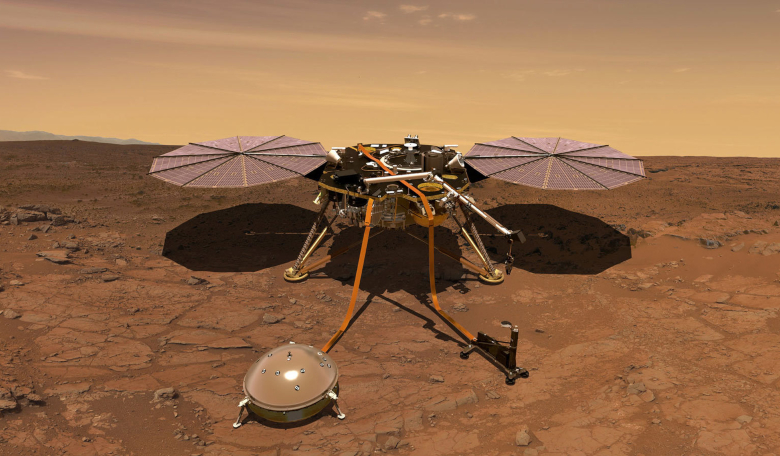Despite a year-long problem trying to hammer into the Martian soil in order to deploy its 40 centimetre-long HP3 instrument, since touching down in the Elysium Planitia region in November 2018, NASA’s InSight lander has been toiling day and night to give scientists an unprecedented look at our nearest planetary neighbour, and it turns out, Mars is a hot-bed of activity both above and below the surface.
In a series of papers published today in Nature Geoscience, scientists reveal that not only does Mars have a magnetic field that is ten-times stronger than previous orbital estimates, as of 30 September 2019, 174 seismic events have been recorded by the lander’s seismometer, meaning they have not been caused by local atmospheric- or lander-induced vibrations.
Of these bonafide marsquakes, 150 are small-magnitude, high-frequency events with waves trapped in the crust, while 24 belong to low-frequency rumblings of magnitude 3–4 rattling about below the crust with waves travelling inside the mantle.
None of the events have reached above magnitude 4, but the cacophony of signals rattling around inside Mars all come from tectonic origins, says W. Bruce Banerdt and colleagues who authored one of the key studies released today. This indicates a seismically active planet rather than one being bombarded by meteorites as signals relating to impact-induced activity have yet to be observed.
The frequency of the internal tremors is above that experienced by the Moon and has been compared to intraplate seismic activity found on Earth. Earthquakes are typically caused by the release of tension built up along plate boundaries. intraplate earthquakes on the other hand occur in the middle of plates far from where ‘normal’ quakes are expected.
Although not a lot is known about intraplate earthquakes, some think they are caused by activity that at some point in Earth's history reduced the strength of the ancient rocky layers that make up the deepest parts of a continental crust; something called concentrated crustal deformation – or CCD.
On Mars, the two largest quakes were located near the Cerberus Fossae region; an area near to InSight’s landing site and one associated with major volcanic and tectonic structures.
However it is possible, say D. Giardini and colleagues who examined Mars’ seismicity activity in more detail, that some of the seismic events could have come from sources such as episodes of underground fluid migration or rock and soil moving down a crater wall over time due to gravity.
Data on Mars’ seismic activity coupled with Gamma Ray Spectrometer chemical mapping has helped another team headed by P. Lognonné and colleagues to paint a picture of what the uppermost layers of the Martian crust are alike.
According to their paper, Mars is encased by a regolith layer just a few metres in depth, under which a much deeper crustal layer extends down to 8 and 11 kilometres.
These crustal layers contain a small amount of volatiles but are mostly composed of basaltic rocks – the same type of rock found in vast quantities on the surface of Earth and the Moon that is formed from the rapid cooling of lava. And considering how much the waves travelling through the crust slow down, P. Lognonné and colleagues suggest these layers are highly altered and/or damaged.
Composition aside, Mars, say P. Lognonné and colleagues is also eerily quiet at night; seismic noise at periods between 4 and 30 seconds is about 500 times lower than Earth’s microseismic noise and is comparable to that recorded by Apollo on the Moon at similar frequencies.
After midnight, the noise increases slightly until sunrise and then rises rapidly after 7.00am (martian time) when ground-transferred wind-generated lander noise and convective atmospheric vortices, or dust devils as they are more commonly known, kick in.
Surprisingly, despite having the largest recorded Martian vortex activity and dust-devil tracks close to the lander, no visible dust devils have been seen, says Don Banfield at Cornell University and colleagues who analysed Mars’ atmosphere in a different paper.
Also unexpected, was the discovery of a phenomena known as airglow. Airglow is faint emissions produced by photochemical reactions and images taken by InSight’s camera show the process taking place in the middle of Mars’ atmosphere. Researchers had speculated that is should exist, but detections fo far have been lacking.
While meteorological measurements do reveal a more dynamic atmosphere than expected, InSight’s instruments also help confirm what is already known about the Red Planet’s atmosphere; it has an average pressure that is 0.6 percent of Earth’s, it’s thin, rich in dust aerosols and as it covers a dry surface there is a scant amount of moist convection circulating the planet.
Also unlike Earth, the atmosphere’s main component, carbon dioxide (CO2), preferentially condenses on the Martian polar regions and in the middle atmosphere.
Overall, the data gleaned so far from the lander’s instruments is proving to be above and beyond what was expected from the Martian surface probe. With the InSight mission expected to continue for an entire Martian year or longer, further measurements should build on these initial results and reveal new discoveries and findings about Mars.











